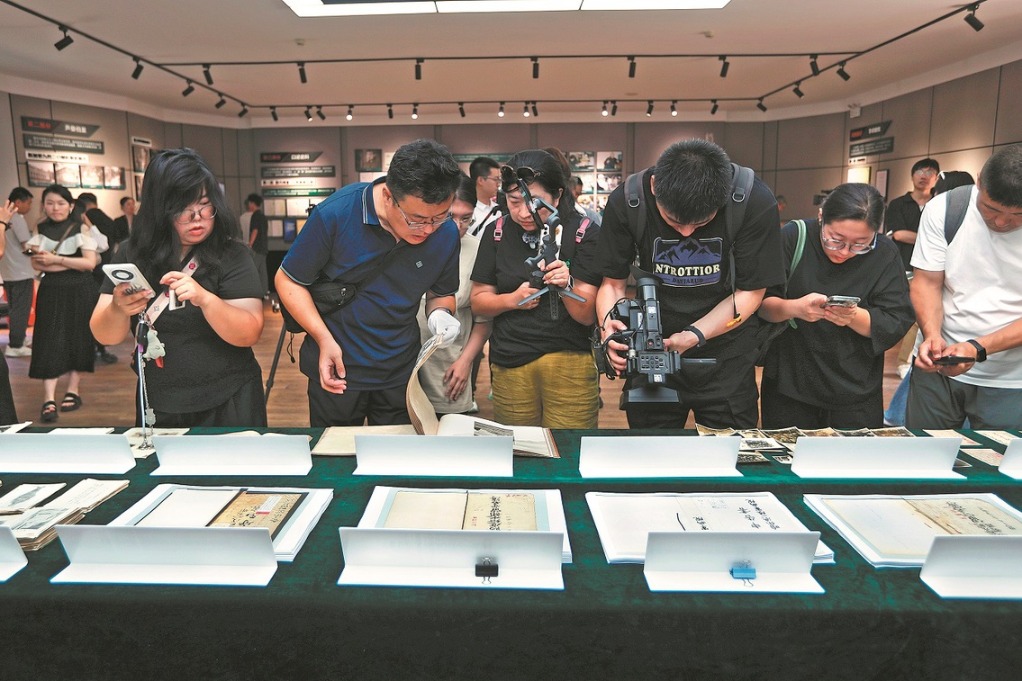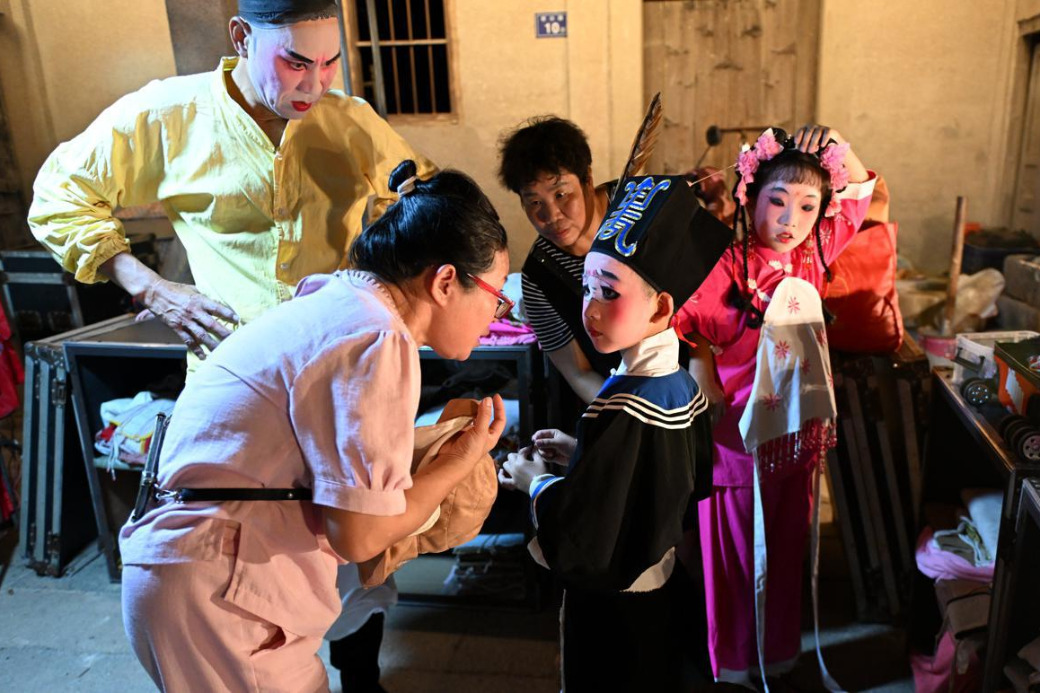History in eight splendid stories

Like the bow of a great ship, it sits there at the corner of two Shanghai streets that form a 30-degree apex where they meet, rising eight stories high.
We are standing outside a building that some say is named after a French World War I battleship, which is fitting given that the Normandie Apartments could not be more anchored to their past.
An inkling of that past is there for all to see in the French Renaissance architecture of the edifice, at the intersection of Wukang Road and Middle Huaihai Road in the former French concession. But hidden within its walls are myriad stories - tales not just of those who lived there, but also of Shanghai, its people, and the city's changing face over more than 90 years.
| The Normandie Apartments, also known as the Wukang Building, have stood since 1924. Gao Erqiang / China Daily |
| From Left: Wu Rujin has lived in the building since she was born in 1952; part of the Normandie Apartments; Tong Rongsheng, 86, who moved in in 1964, and her husband. Photos by Gao Erqiang / China Daily |
| Adam Sinykin, with his wife and daughter, gives an oral history account of the Normandie Apartments. Provided to China Daily |
| Liu Ruilu moved into the Wukang Building in 2006. Provided to China Daily |
| Artist Qin Zhongming lives in the Wukang Building. Gao Erqiang / China Daily |
To ensure those stories are not lost forever, a group led by Shanghai writer Chen Danyan is racing to chronicle them, digging them up, sifting through them and recording them in words, pictures and sounds.
The structure, also known as Wukang Building since the 1950s, was designed by Hungarian-Slovak architect Laszlo Hudec, who bequeathed us two other great Shanghai edifices: the Park Hotel, once the tallest building in Asia, and the Grand Theater.
Witnesses to history and those who care about preserving it are ensuring one corner of a city, and many others like it, are not lost forever
Work on this oral history has so far yielded a 40-minute documentary and a colossal heap of manuscripts and photos. It is all part of efforts by a group of writers and professors to preserve the eastern city's historical buildings and record the past in detail - and they know they must act quickly if they are to succeed.
"We wanted to seize the last chance to ensure that the soul of this old building, which has undergone huge changes, is not lost," Chen says of the Wukang Building. "The need to act is all the more urgent as most of those who first lived there are now advanced in years."
The fruit of those efforts will be exhibited at the Shanghai History Museum next year.
Speaking at a news briefing in May, two years after the history preservation project began, Chen said the work must transcend the physical. "Apart from preserving an old building, there must be something spiritual, something that has the breath of life in it," she said.
While the Wukang Building is lucky to have found friends who care enough to save it from the attentions of those more in tune with progress than preservation, other buildings in Shanghai have not been so lucky, with many already renovated to serve other purposes such as commercial or office spaces. Some have even fallen to the wrecker's ball.
Chen says what the team has done for the Wukang Building can be extended and applied to other historically significant buildings.
"In preserving the memory of a building, priority needs to be given to protecting it physically," she says. "It's fine to nurse wonderful memories, but they alone are not going to prevent an old building from losing its character if someone decides to give it a facelift."
The Wukang Building has its genesis in the International Savings Society, a French financial institute active in the first half of the 20th century, which bought the triangular plot of land at the intersection of Central Huaihai Road and Wukang Road on which the apartment building was erected.
Lu Yun, a spokeswoman for the subdistrict where the building is located, says: "It was designed as an apartment building for white-collar singles. The eight-story building with two elevators was one of the city's earliest modern residential high-rises, and most of those who lived there were upper-class expats. Later, some prominent figures in politics, culture and the arts moved in."
Chen and her colleagues selected a dozen residents, including managers of foreign businesses, university professors and doctors to reflect on some of the building's many cultural faces in different periods.
Adam Sinykin of the United States says when he first laid eyes on the building he was taken by its strong resemblance to the triangular Flatiron Building on New York's Fifth Avenue.
"We feel lucky to live in such a building," says Sinykin, who moved into the building with his wife and daughter in 2007. "Foreigners, especially those with children, have a romantic idea of living in an old building."
Xu Baoying, 81, moved in in 1959. He recalls, "From my room, I had a view of the house of Soong Ching-ling (the wife of Sun Yat-sen, who led the 1911 revolution) across the street. During the food shortages of the 1960s, we saw Soong's chubby nanny strolling in the garden feeding a couple of chickens."

Lin Jianghong, who was born in the building in 1954, says in its heyday the building was peerless in its class.
"There's a layer of felt on the steel window frames to avoid making noise when you shut the windows," says Lin, who used to work for the Shanghai city government. "There's central heating in all the rooms and even the corridors, and if a kitchen is large enough there is a built-in ironing board.
"These things tell a story of how exquisite Shanghai was, too."
Zhou Bingkui, who moved in with his family in 1956 when he was 6, says, "Although the building was designed nearly a century ago, it catered to modern living needs, including a room for a nanny, the kitchen and storerooms."
It was taken over by the Shanghai government in 1953, when it was renamed Wukang Building. In 1994, the building, home to about 140 households, was listed as a city-level historical building.
Contribution
Chen says the residents impressed her team with their interest in the project and with how they went out of the way to help.
"To shoot movies we set up large video cameras and lighting in their rooms, and most interviews lasted for a whole afternoon. What shone through was that all these people are outstanding members of the community who feel it is their duty to make a contribution to the building."
One driving force in her efforts in the project is the fact that she grew up in the area. "Different communities in Shanghai have strong individual characteristics, and I reckon that if you ponder someone's facial expressions for a while you can work out which community they come from. The former French concession community is one of those with a very strong cultural inheritance."
She says she is heartened by the fact more than half the 64 streets in Shanghai in which widening is permanently banned are within the former French concession, because they bear so many of the city's stories.
Li Kan, the local administration official, says the strength of city renewal lies in a community's collective memory and outlook.
"Often enough you can read in books about this brick or that tile that went into old buildings, or see them in museums, but only through the narratives of those who have lived in a building at different times can you produce an accurate history, one that is complete and one that the general public can relate to."
Shanghai has another 11 historical conservation areas. Han Zheng, Party chief of the city, says it is a weighty responsibility for this generation's urban managers to take all the right steps to safeguard and perpetuate the city's spirit and the memories that go with it.
"Hunan subdistrict, which covers just 2 square kilometers, has many outstanding examples of architecture in various styles that have been built over the past 100 years," Han said in May. "Many have been home to outstanding artists, educators, doctors and authors who have made great contributions to the city and to the country."
Sha Yongjie, a member of the Wukang Building project and professor at Tongji University's College of Architecture and Urban Planning, says for architectural aesthetics alone, the Wukang Building is of great value.
"The gate of the building is inconspicuous, which is a show of modesty to its surroundings. However, the lobby on the first floor is spacious, a show of respect to the residents."
Protection
In old communities there has been a push for shikumen, stone-framed gatehouses, to be given protection because they represent an architectural style seen nowhere else in the world.
Shanghai had more than 9,000 shikumen when construction of such homes ended in 1949. About three out of four residents lived in these red-roofed terrace houses, which also served as factories, banks, newspaper offices and schools, according to municipal records.
Just 173 complexes remain intact today and few hold city-level historical building status, meaning they are beyond the scope of regulatory protection.
Feng Xiaomin, director of the cultural and historical data committee of the city's political advisory body, says, "It's understandable that some of the dilapidated old complexes need to make way for high-rise office buildings and malls as Shanghai continues to develop as a cosmopolitan financial center, but that doesn't mean decision-makers should be ruled by the logic of giving priority to land development at the expense of these legacies."
In February, a group of political advisers proposed an application to have the iconic homes that once formed Shanghai's most typical residences included in the world heritage list.
zhouwenting@chinadaily.com.cn
(China Daily Africa Weekly 07/08/2016 page1)
Today's Top News
- Top Chinese diplomat to visit India, hold talks on boundary question
- Trump, Putin tout 'productive' Alaska talks without apparent breakthrough
- A year's rainfall in a single day
- Negotiation the only way out for peace in Ukraine: Editorial flash
- Nation's AI-backed drug market hits global stride
- New evidence of Japanese germ warfare made public



































